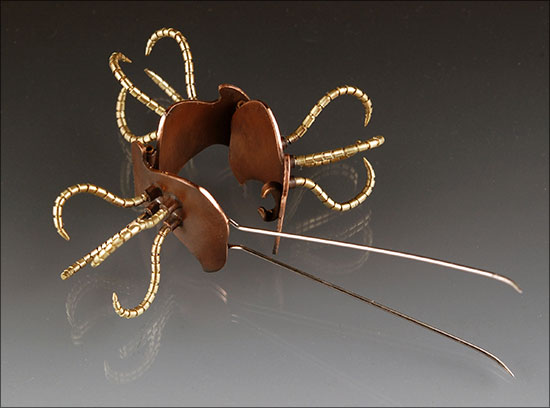Materials: Copper, brass, stainless steel
Dimensions: 1" x 1.5" x 3"
This brooch can articulate when not being worn, but when the pin wire is in the catch, the segments align and are rigid.
Photo credit: Charity Hall
Charity Hall
Tucson, AZ. USA
The study of organisms transcends temporal, cultural, and academic boundaries. My exploration in metalwork and enameling illustrates species through imagery and forms that represent understated facets of biodiversity. I also investigate the anthropomorphic associations and biases that we impart on the organisms and processes we observe, acknowledging constraints inherent to different methods of study. A millipede crawling upon your hand gently tickles. You can feel the overall sensation of movement, but not the individual legs. But if you existed on the same scale as this millipede, it would feel quite differently; its legs formidable, with the tips digging as it marches doggedly along. An artist captivated by the intricate venation pattern of a crane fly’s wing, may entirely neglect the utility of that pattern as a functional architecture of water and nutrient transport. A biologist may destroy the crane fly entirely, crushing its wing to isolate its DNA. However dissect ed, manipulated or exaggerated, each organism remains somewhat elusive, continuing to flourish or perish irrespective to the blinds of human perception. My artwork mimics the observational efforts of scientific pursuit while humoring a quiet rebuttal of species as tangible themes for isolated academic study.
Ganoksin hosts the jewelry list Orchid, with over 13,000 list members from all over the world, speaking from a wide range of technical and aesthetic experiences. The exhibition theme grew out of a desire to celebrate the creativity encompassed in this wide variety.
Artists were free to interpret the theme in any way they chose. Each artist could submit up to six pieces. Interpretations include uniting different materials into one cohesive form; intellectual and emotional “unitings”, where the meaning of the piece unites multiple concepts; the uniting of time - past, present and future; and a number that focus on the harmony created when uniting multiple materials and/or concepts.
The work submitted involved a wide range of jewelry techniques, from very traditional to very cutting edge, as well as using materials from traditional precious metals and gemstones to “re-purposed” and “up-cycled” materials.
The exhibition showcases 330 images chosen from entries from over 111 artists representing 26 countries.
Argentina, Australia, Belgium, Brazil, Canada, Colombia, Czech Republic, France, Greece, India, Israel, Italy, Malta, Mauritius, Mexico, Netherlands, New Zealand, Philippines, Serbia, Spain, Trinidad, Turkey, UK, USA, Venezuela, and the Virgin Islands
Many of the participants began their interest in jewelry at a young age. Some are relative newcomers to the field, and some have over 35 years of experience as professional jewelers and goldsmiths. While some grew up in families that were goldsmiths, and followed in those footsteps, others only began creating jewelry as adults.
